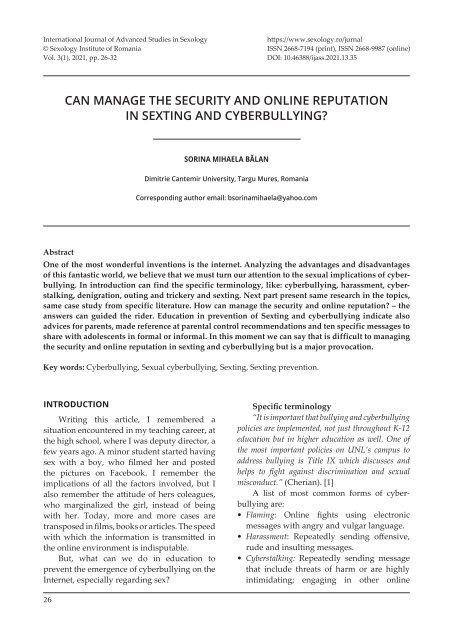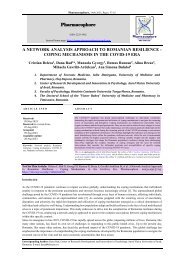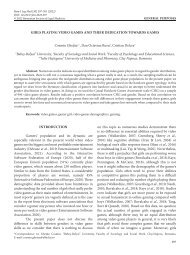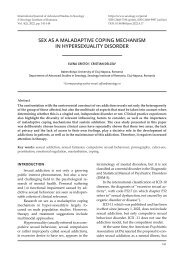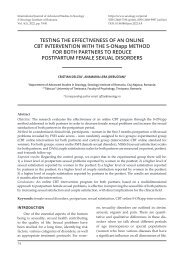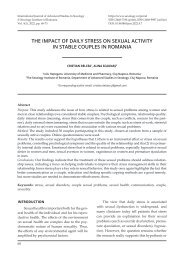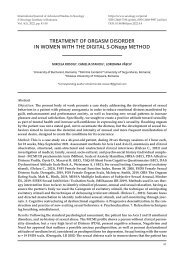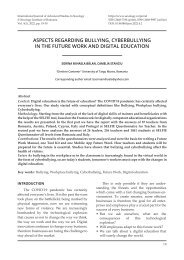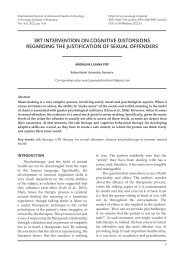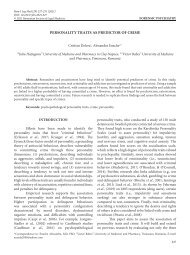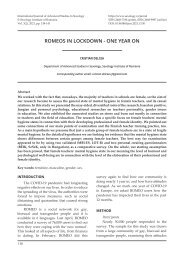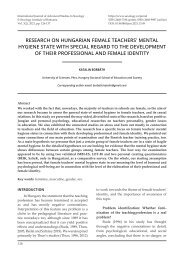26-32 Sorina Mihaela Balan - Can Manage The Security And Online Reputation
You also want an ePaper? Increase the reach of your titles
YUMPU automatically turns print PDFs into web optimized ePapers that Google loves.
International Journal of Advanced Studies in Sexology<br />
© Sexology Institute of Romania<br />
Vol. 3(1), 2021, pp. <strong>26</strong>-<strong>32</strong><br />
https://www.sexology.ro/jurnal<br />
ISSN <strong>26</strong>68-7194 (print), ISSN <strong>26</strong>68-9987 (online)<br />
DOI: 10.46388/ijass.2021.13.35<br />
CAN MANAGE THE SECURITY AND ONLINE REPUTATION<br />
IN SEXTING AND CYBERBULLYING?<br />
SORINA MIHAELA BĂLAN<br />
Dimitrie <strong>Can</strong>temir University, Targu Mures, Romania<br />
Corresponding author email: bsorinamihaela@yahoo.com<br />
Abstract<br />
One of the most wonderful inventions is the internet. Analyzing the advantages and disadvantages<br />
of this fantastic world, we believe that we must turn our attention to the sexual implications of cyberbullying.<br />
In introduction can find the specific terminology, like: cyberbullying, harassment, cyberstalking,<br />
denigration, outing and trickery and sexting. Next part present same research in the topics,<br />
same case study from specific literature. How can manage the security and online reputation? – the<br />
answers can guided the rider. Education in prevention of Sexting and cyberbullying indicate also<br />
advices for parents, made reference at parental control recommendations and ten specific messages to<br />
share with adolescents in formal or informal. In this moment we can say that is difficult to managing<br />
the security and online reputation in sexting and cyberbullying but is a major provocation.<br />
Key words: Cyberbullying, Sexual cyberbullying, Sexting, Sexting prevention.<br />
INTRODUCTION<br />
Writing this article, I remembered a<br />
situation encountered in my teaching career, at<br />
the high school, where I was deputy director, a<br />
few years ago. A minor student started having<br />
sex with a boy, who filmed her and posted<br />
the pictures on Facebook. I remember the<br />
implications of all the factors involved, but I<br />
also remember the attitude of hers coleagues,<br />
who marginalized the girl, instead of being<br />
with her. Today, more and more cases are<br />
transposed in films, books or articles. <strong>The</strong> speed<br />
with which the information is transmitted in<br />
the online environment is indisputable.<br />
But, what can we do in education to<br />
prevent the emergence of cyberbullying on the<br />
Internet, especially regarding sex?<br />
Specific terminology<br />
“It is important that bullying and cyberbullying<br />
policies are implemented, not just throughout K-12<br />
education but in higher education as well. One of<br />
the most important policies on UNL’s campus to<br />
address bullying is Title IX which discusses and<br />
helps to fight against discrimination and sexual<br />
misconduct.” (Cherian). [1]<br />
A list of most common forms of cyberbullying<br />
are:<br />
• Flaming: <strong>Online</strong> fights using electronic<br />
messages with angry and vulgar language.<br />
• Harassment: Repeatedly sending offensive,<br />
rude and insulting messages.<br />
• Cyberstalking: Repeatedly sending message<br />
that include threats of harm or are highly<br />
intimidating; engaging in other online<br />
<strong>26</strong>
<strong>Can</strong> <strong>Manage</strong> <strong>The</strong> <strong>Security</strong> <strong>And</strong> <strong>Online</strong> <strong>Reputation</strong> In Sexting <strong>And</strong> Cyberbullying?<br />
activities that make a person afraid for his<br />
or her safety.<br />
• Denigration: “Dissing” someone online.<br />
Sending or posting cruel gossip or rumors<br />
about a person to damage his or her<br />
reputation or friendships.<br />
• Exclusion: Intentionally excluding someone<br />
from an online group, like a “buddy list” or<br />
a game.<br />
• Impersonation: Breaking into someone’s<br />
account, posing as that person and sending<br />
messages to make the person look bad, get<br />
that person in trouble or danger, or damage<br />
that person’s reputation or friendships.<br />
• Outing and trickery: Sharing someone’s<br />
secrets or embarrassing information online.<br />
Tricking someone into revealing secrets or<br />
embarrassing information, which is then<br />
shared online [2]<br />
Sexting<br />
Sexting is when someone takes a naked or<br />
semi-naked-explicit- picture or video of themselves,<br />
usually using their phone, and sends it<br />
to someone else. Some teens participate in sexting<br />
voluntary as a way to flirt or be intimate<br />
with a romantic partner, while others might be<br />
coerced or manipulated into sharing explicit<br />
images. Due to the varying nature of sexting<br />
incidents, care should be taken to address the<br />
behavior in a way that minimizes harm of the<br />
person depicted, are tips to help parents deal<br />
with sexting when it occurs. [3]<br />
Regarding sexting - sending images or videos<br />
of parts of the body with the authorization<br />
of the sender - Sandoval addressed an important<br />
message: “Sending sexual photos and videos<br />
of minors is child pornography and is a federal<br />
crime” [4]<br />
MATERIAL AND METHODS<br />
<strong>The</strong> author Cherian say that “Cyber bullying<br />
typically starts at about 9 years of age and usually<br />
ends after 14 years of age; after 14, it becomes cyber<br />
or sexual harassment. It affects 65-85% of kids. 90%<br />
of middle school students polled had their feelings<br />
hurt online. 65% of their students between 8-14<br />
have been involved directly or indirectly in a cyber<br />
bullying incident as the cyber bully, victim or friend<br />
and 50% had seen or heard of a website bashing of<br />
another student survey of students nationwide”. [5]<br />
Interesting is the point of view of R.<br />
deSouza & Suely reviewed studies that<br />
“show that both victims and those who practice<br />
cyberbullying undergo negative experiences in<br />
their psychological and behavioral health, where<br />
school dropout may also occur, along with social<br />
isolation, depression, suicidal ideation and suicide.<br />
However, there is hardly any questioning about<br />
cyber culture and how it establishes new socialite’s<br />
– knowledge and debate crucial to understanding<br />
the phenomenon. “[6]<br />
Experiences with older adolescent’s victims<br />
of cyber aggression in a rural community<br />
were explored in the study of Reason, L.,<br />
Boyd, M., & Reason. <strong>The</strong> results showed that<br />
cyber-harassment stems in turn from jealousy of<br />
romantic relationships and cultural, religious<br />
or sexual intolerance, sexual orientation. It<br />
turned out that:<br />
• Cyber attackers tend to be more naughty<br />
and cruel as a result of perceived anonymity;<br />
• Feelings of helplessness and anger were reported<br />
in response to the attacks;<br />
• Lack of knowledge and understanding of<br />
cyberspace has led to a lack of emotional<br />
support and protection against cyber aggression.<br />
[7]<br />
Serrano, AR, & Catalán have made an approach<br />
to cyberbullying in the Spanish social<br />
network Curious Cat, with more than two million<br />
users on an international scale, an analysis<br />
of an incidental non-probabilistic sample<br />
of 1025 users was carried out. <strong>The</strong> results obtained<br />
show that most of the aggressions were<br />
verbal or oriented to the humiliation of the<br />
victim -and often related with the personal life<br />
of the users. <strong>The</strong> victims usually felt detached<br />
with the contents of the aggressions, and the<br />
attackers usually justified their actions sheltering<br />
behind a Justice excuse. [8]<br />
In Guatemala, the campaign<br />
#ElegíCuidarte promotes the responsible use of<br />
connected technologies and protects physical<br />
and emotional integrity minors, social network<br />
users and the internet in general. To promote it,<br />
a light is given about this issue with the video<br />
27
SORINA MIHAELA BĂLAN<br />
“Love Story”, which circulating on the official<br />
channel of Movistar Guatemala, in YouTube.<br />
<strong>The</strong> main message is to prevent children and<br />
adolescents from accepting requests from<br />
strangers in their social networks to avoid being<br />
victims of abuse, such as sexual cyberbullying,<br />
care, sexting, among others. [9]<br />
<strong>The</strong> results of a survey carried out in<br />
20 educational institutions in Asunción and<br />
the interior of the country, on the negative<br />
impact on adolescents of the use of the<br />
Internet and social networks, from Paraguay<br />
show signs of the vulnerability of adolescents<br />
to situations of abuse, such as grooming<br />
(recruitment of adolescents on social networks<br />
and the Internet, for the purposes of sexual<br />
harassment), cyberbullying, sexting, and even<br />
sexual exploitation. [10]<br />
More and more teenagers see sexting as<br />
normal, despite the serious consequences it can<br />
have on their well-being. Little is known about<br />
the factors that facilitate the participation of<br />
adolescents and whether the same factors influence<br />
different types of sexting behaviors<br />
- sending, receiving, forwarding or receiving<br />
through an intermediary - in different ways.<br />
<strong>The</strong> authors Casas, Ojeda, Elipe & Del Rey analyzed<br />
if necessary for popularity, participation<br />
in cyber gossip, social competence, the level of<br />
normalization of sexting and the willingness<br />
to have sex are predicted to what extent adolescents<br />
participate in the activity, and whether<br />
gender influences this participation. 1431<br />
Spanish adolescents, aged between 11 and 18,<br />
participated in a two-wave longitudinal study<br />
with a time lag of four months. For girls, the<br />
most important factors were participation in<br />
cyber gossip and the need for popularity, while<br />
for boys, the most important factors were levels<br />
of normalization and desire to have sex. [11]<br />
Kopecký researching the risky behavior<br />
among Slovak children on the Internet<br />
mentioned “sexting has been related to other<br />
phenomena such as blackmail, bullying,<br />
cyberbullying and extortion”. At the research<br />
was participated 1466 respondents aged 11-<br />
17, boys = 44.96 % and girls = 55.04 %, and has<br />
motorized 2 basic form of sexting distribution<br />
- uploading of the sexually explicit materials<br />
on the Internet (e.g. to the profile of the social<br />
network or to the database of the photo digital<br />
storage device) and direct sending of the<br />
own sexual material to other people (e.g. a<br />
boyfriend, girlfriend, friend, partner etc.) [12]<br />
Case study from specific literature<br />
A 25-year-old man from Sydney has been<br />
accused of using a transport service to threaten,<br />
harass and prosecute crimes, he pleaded guilty<br />
to making sexual threats on social networks, in<br />
what is seen as a case of cyber aggression testing,<br />
specifically he wrote abusive and threatening<br />
comments on a Facebook post about a 25-yearold<br />
girl. A friend of the young man had taken<br />
a screenshot of the victim’s Tinder profile and<br />
posted it on Facebook, where he was shared<br />
thousands of times.<br />
<strong>The</strong> victim spoke publicly about the<br />
abuses she suffered, for fear of provoking a<br />
new reaction, she also said that she is worried<br />
about losing her job and about the upset of<br />
her parents. He called the federal government<br />
to fund a campaign to discourage men from<br />
attacking women online. <strong>The</strong> group “Sexual<br />
violence will not be silenced” was set up in the<br />
hope that this case would set a precedent for<br />
other women to come forward. [13].<br />
Interesting is Bateman’s article, about the<br />
investigation of a series of emails containing<br />
sexually explicit content sent from a University<br />
de Moncton, email account and distributed to<br />
members of an internal group email list. <strong>The</strong><br />
first email contained an “explicit message and<br />
photo with sexual connotation”. As soon as<br />
they got the email, that message and the image<br />
were erased from the system, the university’s<br />
IT staff sent an email to all students and staff<br />
for advising them of the issue and warning<br />
“not to open the email or any similar messages,<br />
and the university is committed to providing<br />
support services to members of the university<br />
community who are victims of sexual<br />
harassment or cyberbullying.” [14]<br />
“She promised young teenage boys sexual<br />
favors in exchange for nude pictures of them. But<br />
“she” turned out to be a 20-year-old man, <strong>And</strong>rew<br />
Newman, admitted to being the online prey of<br />
at least 1,300 boys in Ontario and Quebec in<br />
28
<strong>Can</strong> <strong>Manage</strong> <strong>The</strong> <strong>Security</strong> <strong>And</strong> <strong>Online</strong> <strong>Reputation</strong> In Sexting <strong>And</strong> Cyberbullying?<br />
2015.” He pleaded guilty to more than 400 of<br />
seduction, committing and possession of child<br />
pornography and extortion charges involving<br />
more than 400 charges in Toronto and Quebec.<br />
It is believed to be the largest case of attraction<br />
and child pornography known in <strong>Can</strong>ada.<br />
Newman traded with unsuspecting teenagers<br />
- deceiving them into providing pornographic<br />
images or videos, or sending them porn<br />
videos of a beautiful teenage girl, or offering<br />
them sexual favors in exchange for their own<br />
images. Pazzano & Sun says that “Sextortion<br />
and cyberbullying know no boundaries”, “From<br />
Stouffville to Nova Scotia to Virginia Beach, Va.,<br />
there have been horrific tales of cyberbullying<br />
perpetrated by people from all walks of life”. [15]<br />
How can manage the security and online<br />
reputation?<br />
“Some cyberbullying crosses the line into<br />
unlawful or criminal behavior. Cyberbullying can<br />
harm the online reputations of everyone involved<br />
- not just the person being bullied, but those<br />
doing the bullying or participating in it. Not all<br />
negative interaction online or on social media can<br />
be attributed to cyberbullying. Research suggests<br />
that there are also interactions online that result in<br />
peer pressure, which can have a negative, positive,<br />
or neutral impact on those involved.”[5]<br />
Referring the subject Teen sexting, Hinduja,<br />
& Patchin give ten advice for the parents [4]:<br />
• Gather information<br />
• Stop the bleeding<br />
• Talk whit child<br />
• Be discrete<br />
• Camden the behavior, not the child<br />
• Contact other parents<br />
• Contact the school<br />
• Contact the police<br />
• Seek professional help<br />
• Offer alternatives to sexting identity,<br />
intimacy and relationships.<br />
Rebecca Garza Bueron, an expert in internet<br />
security, urged parents to know the use and<br />
scope of sites and electronic devices to which<br />
their children have access and thereby regain<br />
control over the use and security settings of<br />
the cell phone, IPad, Xbox and internet sites<br />
like Google and YouTube. She shared ways to<br />
configure YouTube, Google, Play Store, Netflix<br />
and Xbox to have more parental control:<br />
• Safe zones - Internet safety specialist Rebeca<br />
Garza Buerón shared with parents some tips<br />
for setting up programs and websites.<br />
• Youtube - Activate filters to prevent children<br />
from taking inappropriate videos or use<br />
YouTube Kids for children under 8 years old.<br />
• Instagram -Be aware of who follows your<br />
children and who they follow.<br />
• Google - Activate the “Safe Search” filter in<br />
the settings.<br />
• Netflix- Open an account for children where<br />
their age is specified so that they have access<br />
to controlled content.<br />
• Google Store- Activate “Parental Control”<br />
to restrict downloads and purchases. [16]<br />
In <strong>Can</strong>ada, a specific law on revenge has<br />
been created, which allows the victim to sue for<br />
restitution. <strong>The</strong> law, called “<strong>The</strong> Privacy Act”,<br />
applies to anyone who can be identified in a<br />
photo or video, who appears naked or engaged<br />
in sexual activity, taken in circumstances where<br />
they would have a reasonable expectation of<br />
privacy. Eg. <strong>The</strong> case “Jane Doe 464533 v. ND”,<br />
an Ontario Superior Court judge recognized<br />
for the first time in <strong>Can</strong>ada the privacy tort of<br />
“publication of embarrassing private facts” and<br />
the judge found for the plaintiff and awarded<br />
approximately $142,000 in damages against<br />
a former boyfriend who posted a sexually<br />
explicit video of victim online.[17]<br />
Education in prevention of sexting and<br />
cyberbullying<br />
In this digital world, all mankind must<br />
adapt their actions in combating any cybernetic<br />
sexual acts that harm the human being.<br />
In <strong>Can</strong>ada, an attempt by a school in Hamilton<br />
to change the curriculum, it was argued<br />
that the 1998 Curriculum has “written in a world<br />
where cellphones, sexting, cyberbullying, and online<br />
porn didn’t exist”, <strong>The</strong> Conservatives’ decision<br />
has named “a giant step backwards.”,<br />
the bord of school say “we know that these are<br />
realities that particularly young women face online.<br />
That’s not being addressed, and that seriously<br />
concerns me”, “We live in a hyper-hyper-sexualized<br />
world. <strong>The</strong> largest users of online porn<br />
29
SORINA MIHAELA BĂLAN<br />
are boys between 12 and 17 - is that where we<br />
want kids to be getting their sexual education<br />
from?”[18]<br />
“Some new dangers have arrived, like sexting,<br />
cyberbullying, and problems that I don’t remember<br />
children bringing to us in 1986, like self-harm<br />
and eating disorders, which have become almost<br />
an epidemic, and the really worrying thing is the<br />
number of suicidal young people has doubled in the<br />
last five years.” [19] , Kopecký recommendations<br />
is “to pay a large attention to the prevention of<br />
this phenomenon in particular (n.a.sexting), and<br />
to introduce the concrete consequences resulting<br />
from this behavior to the adolescents. An ideal way<br />
is to present the concrete examples to the children,<br />
showing damage caused to the victim (victim´s<br />
suicide in extreme cases). Public education focused<br />
on the parents or teachers presents an integral part<br />
of the sexting prevention.”[12]<br />
In some workshops on the sexting topics,<br />
the participants discussed different tactics that<br />
t the girl could use to divert persistent requests<br />
for nudes and unsolicited images. One suggested<br />
tactic was to change the subject of the<br />
conversation “as fast as you can” or ignoring<br />
the requester for a period of time. [20]<br />
Patchin & Hinduja suggested themes encapsulated<br />
in 10 specific messages to share<br />
with adolescents in formal or informal contexts<br />
after weighing their developmental and sexual<br />
maturity:<br />
1. If someone sends you a sext, do not send it<br />
todor showd anyone else;<br />
2. If you send someone a sext, make sure you<br />
know and fully trust them;<br />
3. Do not send images to someone who you are<br />
not certain would like to see it;<br />
4. Consider boudoir pictures. Boudoir is a genre<br />
of photography that involves suggestion<br />
rather than explicitness. Instead of nudes,<br />
send photos that strategically cover the most<br />
private of private parts;<br />
5. Never include your face;<br />
6. Make sure the images do not include<br />
tattoos, birthmarks, scars, or other features<br />
that could connect them to you, remove all<br />
jewelry before sharing:<br />
7. Turn your device’s location services off for<br />
all of your social media apps, make sure<br />
your photos are not automatically tagged<br />
with your location or username, and delete<br />
any metadata digitally attached to the image;<br />
8. If you are being pressured or threatened to<br />
send nude photos, collect evidence when<br />
possible;<br />
9. Use apps that provide the capability for sent<br />
images to be automatically and securely<br />
deleted after a certain amount of time;<br />
10. Be sure to promptly delete any explicit<br />
photos or videos from your device. [21]<br />
CONCLUSIONS<br />
<strong>Can</strong> talk about the “reciprocal relationships<br />
between the perpetration of traditional bullying,<br />
cyberbullying, and four forms of sexting: sending,<br />
receiving, third-party forwarding, and receiving<br />
sexts via an intermediary” because “Involvement<br />
in bullying and cyberbullying appears to be a<br />
vicious cycle, with engagement in either form of<br />
aggression associated with a raised likelihood of<br />
later involvement in the other”. [22]<br />
Efforts must be made to prevent and<br />
educate on this phenomenon, which has<br />
become widespread in recent years, related to<br />
sexing and cyberbullying.<br />
It is time to talk about this phenomenon<br />
and “take the skeletons out of the closet”, in 2015<br />
Romania is otherwise ranked 2nd in Europe in the<br />
phenomenon of “sexting”.[23]<br />
Parental involvement in children’s online<br />
activities according to the results of research<br />
conducted by Csipkes is not associated with<br />
the phenomenon of sexting, suggesting an<br />
“inefficiency or difficulty in educating children<br />
on virtual behavior. Nor the training courses from<br />
during school hours does not seem to influence the<br />
phenomenon of sexting.” [24]<br />
Phenomena such as cyber sexism, cyber<br />
misogyny and erotic messages (sexting) have<br />
in common that they are all based on deeprooted<br />
gender stereotypes, ideas about what<br />
women / girls and men / boys are or should<br />
be, stereotypes can be rigidly prescriptive. [25]<br />
[<strong>26</strong>] [27] [28] [29]<br />
30
<strong>Can</strong> <strong>Manage</strong> <strong>The</strong> <strong>Security</strong> <strong>And</strong> <strong>Online</strong> <strong>Reputation</strong> In Sexting <strong>And</strong> Cyberbullying?<br />
REFERENCES<br />
[1] Cyberbulling problem demands a solution. (2016,<br />
Sep 16). University Wire, Accesd in <strong>26</strong>.02.2021<br />
from: https://search-proquest-com.am.e-nformation.ro/wire-feeds/cobb-cyberbulling-problem-demands-solution/docview/1819927830/<br />
se-2?accountid=136549<br />
[2] Willard, Nancy. An Educator’s Guide to Cyberbullying<br />
and Cyberthreats. Center for Safe and<br />
Responsible Internet Use, accesed from http://<br />
www.cyberbully.org/cyberbully/docs/cbcteducator.pdf<br />
[3] Sameer Hinduja, Ph.D. and Justin W. Patchin,<br />
Ph.D. Teen Sexting.Top Ten Tips 2021 Cyberbullying<br />
Research Center | cyberbullying.org [4] Nerio,<br />
K., & González, L. (2016, Nov 06). Dan a papás<br />
tips tecnológicos. El Norte Retrieved from<br />
https://search-proquest-com.am.e-nformation.<br />
ro/newspapers/dan-papás-tips-tecnológicos/<br />
docview/1836390301/se-2?accountid=136549<br />
accesed in 27.02.2021<br />
[5] Cherian, V. E. (2019). Cyberbulling. Research<br />
Journal of Science and Technology, 11(1),<br />
73-76. doi:http://dx.doi.org.am.e-nformation.ro/10.5958/2349-2988.2019.00011.1.<br />
Accesed in <strong>26</strong>.02.2021 from https://<br />
search-proquest-com.am.e-nformation.<br />
ro/docview/2271754419/735477B042B<br />
44273PQ/2?accountid=136549<br />
[6] Taiza Ramos deSouza, C. F., & Suely, F. D.<br />
(2018). Cyberbulling: Conceituações, dinâmicas,<br />
personagens e implicações à saúde. Ciência<br />
& Saúde Coletiva, 23(10) doi: http://<br />
dx.doi.org.am.e-nformation.ro/10.1590/1413-<br />
812<strong>32</strong>0182310.13482018 accesed in <strong>26</strong>.02.2021<br />
from https://search-proquest-com.am.e-nfor<br />
mation.ro/docview/2129605837/735477B042B<br />
44273PQ/4?accountid=136549<br />
[7] Reason, L., Boyd, M., & Reason, C. (2016). Cyberbullying<br />
in rural communities: Origin and<br />
processing through the lens of older adolescents.<br />
<strong>The</strong> Qualitative Report, 21(12), 2331-2348. Retrieved<br />
from https://search-proquest-com.<br />
am.e-nformation.ro/scholarly-journals/cyberbullying-rural-communities-origin-processing/<br />
docview/1867930055/se-2?accountid=136549<br />
[8] Serrano, AR, & Catalán, SG (2018). Prevalence,<br />
Motivations <strong>And</strong> Affective Responses Of Cyberbullying<br />
In <strong>The</strong> Anonymous Social Network Curious<br />
Cat. Social Prism, (23), 353-365. Accessed in<br />
27.02.2021 from https://search-proquest-com.<br />
am.e-nformation.ro/scholarly-journals/prevalencia-motivaciones-y-respuestas-afectivas/<br />
docview/21909<strong>26</strong>973/se-2?accountid=136549<br />
[9] Movistar presenta #ElegíCuidarte, para el uso seguro<br />
del internet. Prensa Libre; Guatemala (2017). Accesed<br />
in 27.02.2021 from https://search.proquest.<br />
com/blogs,-podcasts,-websites/movistar-presenta-eleg%EF%BF%BDcuidarte-para-el-uso/<br />
docview/1958054572/se-2?accountid=136549<br />
[10] Study on the impact on adolescents of the use of the<br />
internet and social networks. (2017). Accesed in<br />
27.02.2021 from https://search-proquest-com.<br />
am.e-nformation.ro/docview/1912897308/<br />
fulltext/735477B042B44273PQ/10?accountid=136549<br />
[11] José A. Casas, Mónica Ojeda, Paz Elipe, Rosario<br />
Del Rey, Exploring which factors contribute<br />
to teens’ participation in sexting, Computers in<br />
Human Behavior, Volume 100, 2019, Pages 60-<br />
69, ISSN 0747-56<strong>32</strong>, https://doi.org/10.1016/j.<br />
chb.2019.06.010 accessed in 28.02.2021 from<br />
https://www.sciencedirect.com/science/article/pii/S074756<strong>32</strong>19302286<br />
[12] Kamil Kopecký, Sexting Among Slovak Pubescents<br />
and Adolescent Children, Procedia - Social<br />
and Behavioral Sciences, Volume 203,<br />
2015, Pages 244-250, ISSN 1877-0428, https://doi.<br />
org/10.1016/j.sbspro.2015.08.289. Accesed in<br />
28.02.2021 from https://www.sciencedirect.<br />
com/science/article/pii/S187704281504937X<br />
[13] Jackson, V. (2016, Jun 20). Zane alchin pleads<br />
guilty to making facebook threats about olivia melville<br />
tinder profile: A sydney man pleads guilty<br />
to making sexual threats on social media about<br />
25-year-old olivia melville’s tinder profile, in what<br />
is being seen as a cyber-bullying test case. ABC<br />
Premium News, accessed in 27.02.2021, from<br />
https://search-proquest-com.am.e-nformation.<br />
ro/wire-feeds/zane-alchin-pleads-guilty-making-facebook-threats/docview/1797812077/<br />
se-2?accountid=136549<br />
[14] Bateman, T. (2017, Feb 28). ??Explicit emails<br />
sent from UdeM account. Telegraph-Journal<br />
accesed in 28.02.2021 from https://searchproquest-com.am.e-nformation.ro/newspapers/explicit-emails-sent-udem-account/<br />
docview/1872434493/se-2?accountid=136549<br />
[15] Sam Pazzano, T. S. (2017). Wannabe soldier<br />
preyed on young boys online. Accesed in<br />
27.02.2021 from https://search-proquest-com.<br />
am.e-nformation.ro/docview/2201580155/<br />
fulltext/735477B042B44273PQ/22?accountid=136549<br />
31
SORINA MIHAELA BĂLAN<br />
[16] Nerio, K., & González, L. (2016, Nov 06). Dan<br />
a papás tips tecnológicos. El Norte accesed in<br />
28.02.2021 from https://search-proquest-com.<br />
am.e-nformation.ro/newspapers/dan-papás-<br />
tips-tecnológicos/docview/1836390301/se-<br />
2?accountid=136549<br />
[17] Star, E. B. (2017). We can do more to fight<br />
‘revenge porn’: Editorial. <strong>The</strong> Toronto Star<br />
(<strong>Online</strong>), Toronto: Torstar Syndication Services,<br />
a Division of Toronto Star Newspapers<br />
Limited. Accesed in 28.02.2021 from https://<br />
search-proquest-com.am.e-nformation.ro/<br />
docview/1919084082/fulltext/735477B042B<br />
44273PQ/30?accountid=136549<br />
[18] Esther rantzen pleads for more childline<br />
volunteers [scot region]. (2016, Oct 28). <strong>The</strong><br />
Times Accessed in 28.02.2021 from https://<br />
search-proquest-com.am.e-nformation.ro/<br />
newspapers/esther-rantzen-pleads-more-<br />
childline-volunteers/docview/1833027083/se-<br />
2?accountid=136549<br />
[19] Ford’s sex ed decision met with outcry.<br />
(2018). <strong>The</strong> Hamilton Spectator (<strong>Online</strong>),<br />
Hamilton: Torstar Syndication Services,<br />
a Division of Toronto Star Newspapers<br />
Limited. Jul 13, 2018. Accessed in February<br />
2021 from https://search.proquest.com/<br />
docview/2068823490?accountid=136549<br />
[20] Brandee Thorburn, Nicola Gavey, Grace Single,<br />
April Wech, Octavia Calder-Dawe, Paulette<br />
Benton-Greig, To send or not to send nudes: New<br />
Zealand girls critically discuss the contradictory<br />
gendered pressures of teenage sexting, Women’s<br />
Studies International Forum, Volume 85, 2021,<br />
102448, ISSN 0277-5395,<br />
https://doi.org/10.1016/j.wsif.2021.102448. Accesed<br />
on 27.02.2021 from https://www.sciencedirect.<br />
com/science/article/pii/S0277539521000121<br />
[21] Justin W. Patchin, Sameer Hinduja, It is Time<br />
to Teach Safe Sexting, Journal of Adolescent<br />
Health, Volume 66, Issue 2, 2020,<br />
Pages 140-143, ISSN 1054-139X,<br />
https://doi.org/10.1016/j.jadohealth.2019.10.010<br />
accessed in February 2021 from https://<br />
www.sciencedirect.com/science/article/pii/<br />
S1054139X19305099<br />
[22] Mónica Ojeda, Rosario Del Rey, Simon C.<br />
Hunter, Longitudinal relationships between<br />
sexting and involvement in both bullying and<br />
cyberbullying, Journal of Adolescence, Volume<br />
77, 2019, Pages 81-89,<br />
ISSN 0140-1971, https://doi.org/10.1016/j.adolescence.2019.10.003.<br />
Accessed in 28.02.2021 from<br />
https://www.sciencedirect.com/science/article/pii/S0140197119301617<br />
[23] Romania, locul 2 in Europa la fenomenul SEXTING.<br />
Ce trebuie sa stie minorii care isi fac cont pe retelele<br />
sociale (2015), Stirileprotv accesat in <strong>26</strong>.02.2021<br />
from https://stirileprotv.ro/stiri/social/<br />
romania-locul-2-in-europa-la-fenomenulsexting-45-dintre-minorii-romani-au-fostagresati-pe-internet-sfaturile-expertilor.html<br />
[24] Csipkes Hajnalka-Szende, <strong>The</strong> Phenomenon<br />
Of Sexting Among Teenagers, 2018, Journal<br />
Of Romanian Literary Studies, accessed in<br />
28.02.2021 from https://old.upm.ro/jrls/JRLS-<br />
13/Rls%2013%2085.pdf<br />
[25] Siserman C., Giredea C., Delcea C.,* (2020).<br />
<strong>The</strong> Comorbidity of Paraphilic Disorders and<br />
Rape In Individuals Incarcerated For Sexual<br />
Offences. Rom J Leg Med [28] 278-282 [2020]<br />
DOI: 10.4<strong>32</strong>3/rjlm.2020.278.<br />
[<strong>26</strong>] Delcea C., Rusu O. D., Matei V. H., Vica<br />
M. L., Siserman C., (2020). <strong>The</strong> Evidence-<br />
Based Practice Paradigm Applied to Judicial<br />
Psychological Assessment In <strong>The</strong> Context of<br />
Forensic Medicine. Rom J Leg Med [28] 257-<br />
<strong>26</strong>2 [2020] DOI: 10.4<strong>32</strong>3/rjlm.2020.257.<br />
[27] Popa-Nedelcu R., Delcea C.,* Siserman<br />
C., Carmen Domnariu D. C., 2020: <strong>The</strong><br />
relationship between personality disorders<br />
and domestic violence in forensic context. Rom<br />
J Leg Med28(2)166-171(2020). DOI:10.4<strong>32</strong>3/<br />
rjlm.2020.166. Romanian Society of Legal<br />
Medicine.<br />
[28] Delcea C.,* Siserman C., 2020: Validation and<br />
Standardization of the Questionnaire for<br />
Evaluation of Paraphilic Disorders. Rom<br />
J Leg Med28(1)14-20(2020) DOI:10.4<strong>32</strong>3/<br />
rjlm.2020.14Romanian Society of Legal<br />
Medicine.<br />
[29] Delcea C.,* Muller-Fabian A., Radu C. C., Perju-<br />
Dumbravă D., 2019: Juvenile delinquency<br />
within the forensic context. Rom J Leg Med<br />
[27] 366-372 [2019] DOI: 10.4<strong>32</strong>3/rjlm.2019.366<br />
© 2019 Romanian Society of Legal Medicine.<br />
<strong>32</strong>


